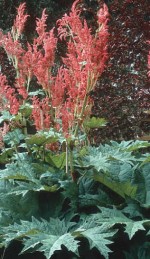 This giant of plants is not for a small garden but where there is space and suitable light and moisture it is magnificent! Sure, it is similar to common garden rhubarb but as though it were on steroids. It not only features large size but also has amazing color. In early spring when the large leaves first appear they are plum red with red veins visible on the underside. As the leaves unfurl from a cigar shaped mass and turn green, reddish stems are revealed. In late spring, masses of small deep cherry red flowers are produced on stalks that stand 5-7’ above the deeply cut and lobed leaves. The plant is not difficult to grow if certain basic needs are met and one of the most important of these is adequate moisture throughout the growing season. Ornamental rhubarb is sensitive to heat and drought and will decline badly by mid summer if plenty of moisture is not available. In addition, it needs a big supply of nutrients to support its large size so a top dressing of manure or compost is required each spring. It likes full sun in the North but prefers afternoon shade in the South and once established it will persist for many years.
This giant of plants is not for a small garden but where there is space and suitable light and moisture it is magnificent! Sure, it is similar to common garden rhubarb but as though it were on steroids. It not only features large size but also has amazing color. In early spring when the large leaves first appear they are plum red with red veins visible on the underside. As the leaves unfurl from a cigar shaped mass and turn green, reddish stems are revealed. In late spring, masses of small deep cherry red flowers are produced on stalks that stand 5-7’ above the deeply cut and lobed leaves. The plant is not difficult to grow if certain basic needs are met and one of the most important of these is adequate moisture throughout the growing season. Ornamental rhubarb is sensitive to heat and drought and will decline badly by mid summer if plenty of moisture is not available. In addition, it needs a big supply of nutrients to support its large size so a top dressing of manure or compost is required each spring. It likes full sun in the North but prefers afternoon shade in the South and once established it will persist for many years.
Type: Herbaceous perennial
Bloom: Masses of small cherry red flowers are borne on 5-7’ stems for about 2 weeks in summer.
Foliage: Deeply cut and lobed leaves 2-3’ wide leaves are red when they emerge and slowly turn green.
Size: 5-7’ H x 6’ W
Light: Full sun in North, afternoon shade in South
Soil: Rich, humusy, moist, well-drained.
Fertilizer: Top dressing of manure or compost in spring.
Hardiness: Zones 4-7
Care: Cut flower stalk after flowering to maintain vigor.
Pests and Diseases: None of importance; deer resistant.
Propagation: Divide in fall or spring making sure that each piece of root has an eye/bud.
Companion plants: ‘Husker Red’ penstemon, ‘David’ garden phlox (Phlox paniculata), rodgersia (R. aesculifollia), variegated solomon’s seal, red peony, and spring bulbs such as anemone blanda.
